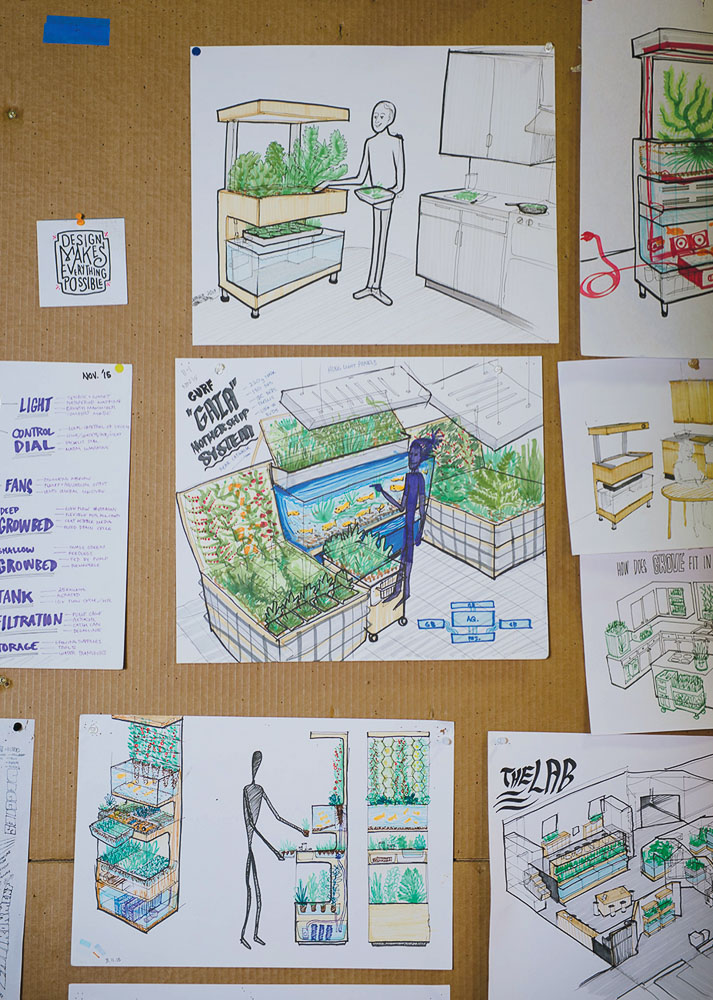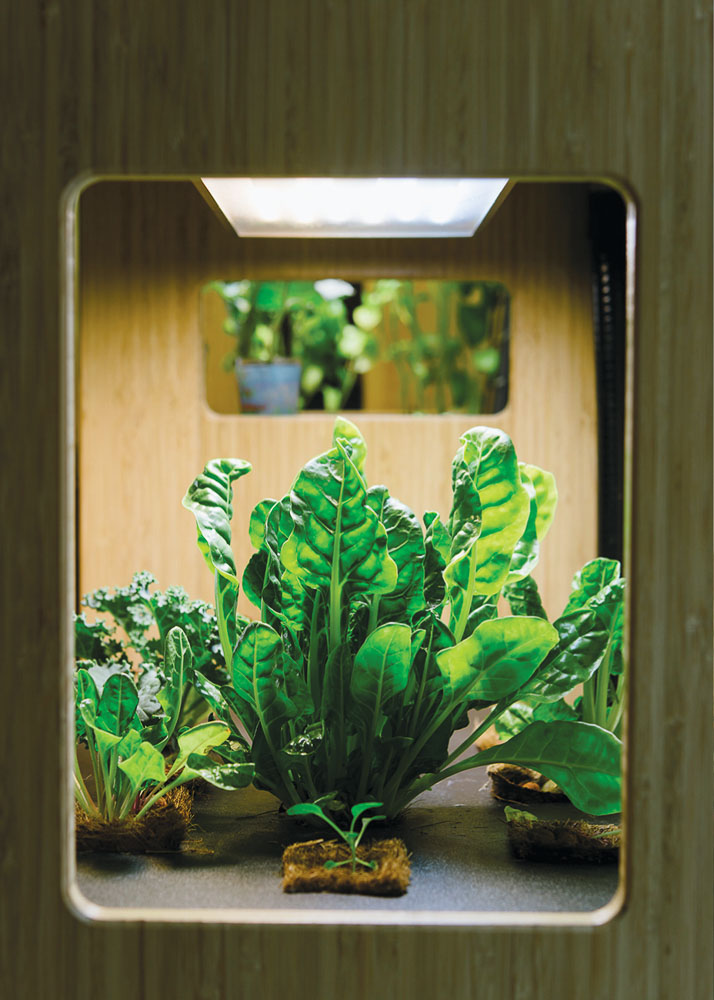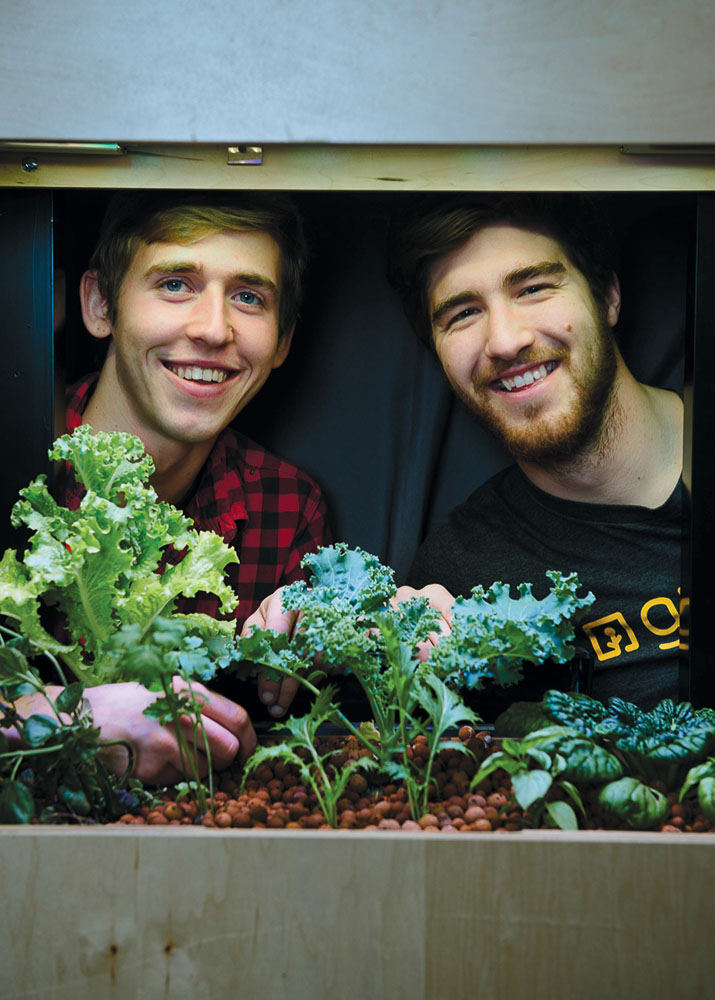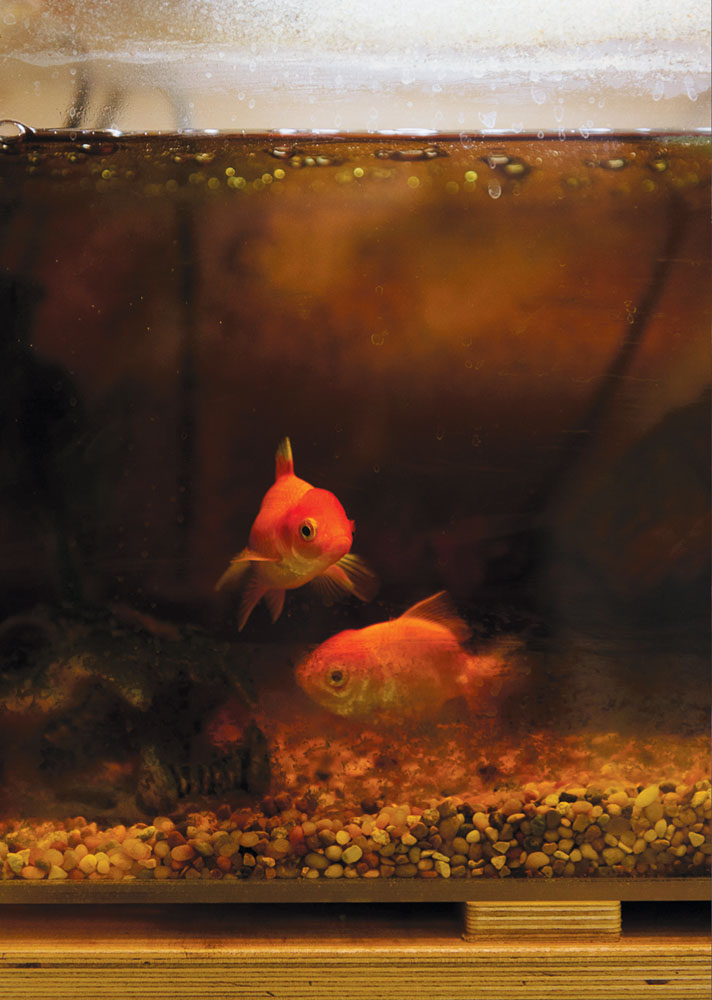Gotta Get a Grove
PHOTOS BY KATIE NOBLE
Kristine Mozes knew she was spending entirely too much time fiddling with the leaves on the newest distraction in her kitchen, a bookshelf sized contraption filled with LED lights, green growing things and a tank of wriggling fish. Her Grove Early Adopter Ecosystem arrived at the Mozes’ Lexington home in late June, and ever since then the indoor aquaponics edible garden has consumed far more of Kristine’s time and energy than she likes to admit. On sunny mornings and on rainy evenings, she noticed herself snipping a few fronds of thyme, harvesting French lettuce or romaine, and regularly checking on the health of her tomatoes far more often than the plants required. Does she really care that much about how fast her collard greens grow? Yes. “It’s a little like raising kids. Small almost imperceptible changes everyday, and then wow,” she says.
The Grove Ecosystem is an intelligent, indoor garden that helps people grow fresh, flavorful, and nutrient-rich food in any room of the house. The Ecosystem uses natural microbes, the bacteria from the fish in its self-contained tank, to grow vegetables, herbs, and small fruits year round at home. It’s a symbiotic and closed system where the nutrients from the fish nourish the plants and the plants clean the water for the fish. Users tap into the Grove App, and connect with other users as they share successes and failures. The company estimates that the Ecosystem uses about 112.2 kilowatts a day, which translates into an average energy cost of 54 cents a day. They also claim that the Grove produces edible plants 50-75% faster than an outdoor garden and is twice as productive per square foot.
Kristine is transfixed by every aspect of her “Grove.” “I love to look at it, touch it, marvel at it. I keep interacting with it in my kitchen all day long.” Is it an appliance or a piece of furniture— or the building block of a sustainable lifestyle? She is not exactly sure. But she is sure that the Grove is synchronous with her values and her current lifestyle. With two active teenage boys at home, Ben, 16, and Josh, 13, Kristine has temporarily put her career as an investor communications executive on hold, and is spending more time tending to things she loves: baking bread from scratch, making her own cheese and pasta, and keeping her family’s food intake as clean and green as possible.
Kristine’s tomato plant was just retired last month after months of productive service. She is using a clipping now from the old tomato plant to jumpstart the next crop. Her family had salad and tomatoes almost daily from their Grove from September to end of December. A great moment in Mozes’ family lore is the day she saw son Ben casually snipping basil leaves to add to the salad he was making for himself.
She doesn’t have to spend much time on the system now. There’s an automatic feeding system for the fish that she has to check occasionally, and every week or so, she needs to add a gallon or so of water to the fish tank, and once in a while, she needs to make sure that the root system doesn’t overgrow the pumps. She tests the pH weekly, more or less, but now that the system has been in place for several months and the fish are thriving, the pH is pretty stable. There is precious little busy work to do. In fact, there’s not much to do other than harvesting the vegetables and thinking about what to plant next. Kristine enjoys checking in on-line with the other early adopters in the “community,” she says. “People are so willing to problem solve together. It’s a very engaged community—except for the lurkers.”
Does her Ecosystem make economic sense? Even at the early adopter’s price of $1950, it’s hard to argue that the dollars make sense. Two grand can buy you a lot of tomatoes, parsley, arugula and Serrano peppers. It's doubtful the purchase of a Grove Ecosystem, or its like, will ever be a purely financial decision. It’s more a declaration of values, being so invested in the sustainable food system that you just have to have your own bit of organic garden under your roof.
Grove Labs is a Somerville-based start-up. The company was willed into being by Co-founder and CEO, Gabe Blanchet, and Co-Founder and Inventor Jamie Byers, two best friends tinkering in their MIT fraternity dorm room. Grove Labs is in the vanguard of companies aiming to make growing your own food an achievable and affordable goal for suburbanites and city dwellers alike. The company, which will start national distribution of its approximately $4,500 plug-and-play Grove Ecosystem, has attracted over $4 million in financing from angel investors and a Kickstarter campaign and has now gone national. Of the over half-million dollars raised in the Kickstarter campaign, 126 out of the 512 backers purchased an Ecosystem. That’s got to be some kind of record.
Gabe, now 24, explains, “Jamie and I started Grove because we believe that, in the future, everybody needs more access to fresh, healthy locally grown food. And that one of the best ways to promote that is to help people grow it themselves.” When Jamie built a basic aquaponics system in their fraternity room at MIT two years ago, the roommates realized they had constructed a full living eco system in a fraternity room, and could have fresh greens every day, even in the dead of winter. “The spark for Grove was born. We thought that by empowering people to grow their own food they could make better choices, healthier, and more conscious choices about what they are putting into their bodies.”
Like 99% of Americans, neither Jamie nor Gabe is a farmer nor is either the child or grandchild of farmers. Though each had gardens as kids, agriculture wasn’t under their fingernails. Engineering was their future. And each was dedicated to using their top-flight MIT engineering education to make a positive impact in the world.
Jamie, educated as an aerospace engineer, planned to combat the effects of global climate change by working on alternative energy sources to petroleum and coal. But the summer before his senior year he worked on an experimental farm in West Virginia, an experience that opened his eyes to the fact that, in addition to energy, agriculture accounts for a huge amount of global carbon emissions and contributes to the degradation of our soil as nitrates and other fertilizers run off and create problems with ecosystems all over the world. Gabe remembers Jamie excitedly explaining to him in their dorm room, that “algae blooms in the ocean have created huge dead zones where there used to be thriving forests.” Jamie came out of his summer on the farm convinced that current agricultural practices had created big environmental problems globally and that “he needed to be part of the solution.”
Jamie began tinkering with ideas in their dorm room. Aquaponics seemed the most promising technology he contemplated. There are two water based food-growing technologies: aquaponics, which the Grove Ecosystem uses, is a technology that uses the naturally-occurring bacteria of fish to fertilize the plants. The nitrates and other waste products from the fish turn into valuable nutrients for plants and herbs. Hydroponics depends on adding external nutrients to purified water to help plants thrive. Each approach has its pros and cons, but it was the circularity of aquaponics that grabbed Jamie. He loved the idea that, just like in nature, he could mirror a system where the fish nourished the plants, the plants improved the water and a simple efficient pump made it all go round.
The idea was part of Jamie’s journey as a mission-oriented engineer. In fact, when he first started to build the prototype in their dorm room, Gabe was against the whole idea. “I thought it would smell, and be too big and loud, and there would be all these problems with our fraternity brothers.” Jamie built it anyway. And their room became a centerpiece, a gathering place for the fraternity. “People used to come in and hang out. Feed the fish, pick the lettuce, and drink beer,” Gabe says. In retrospect, the two founders admit it might have seemed a little crazy to others “to be growing food in their dorm room and have fun hooking up all the data about the pH levels in the water up to their smartphones. “But none of that seemed too crazy to us. It seemed very much like just a normal day. It was fun.”
Gabe and Jamie started to talk about building a company around the Ecosystem. MIT may be one of the most nurturing institutions in the country for a young entrepreneur with a big bold idea. The university has entrepreneurial mentors, programs and technical advisors available to students with marketable ideas. And after all, MIT was first founded as a land grant university with agriculture and agricultural engineering as one of its pillars, though most of us have forgotten that. Gabe smiles knowingly, “In the next few years, you are going to see a lot of ideas coming out of MIT that will have direct impact on the future of food in our world.”
Gabe had the natural instincts and the experience to start a venture. He had taken a year off from school to work as a first hire for another start-up, GrabCAD, after their $1.4 million seed round of financing. Gabe watched the company grow from 5 to 40 employees and from 60,000 to 1.2 million users. Three years later, GrabCAD sold to Statysys for $100 million. Gabe knew it could be done. And he knew that Boston, weak on plantable acres but strong on ingenuity, could be an epicenter for innovation in agriculture.
He “loved the notion of using cutting-edge technology to shift the means of food production into the hands of more people. “Why should we jam all our food production in the Midwest and in California valleys? Now is the time to democratize the food system with all these cool tools and access to information that can empower people to be makers and builders, and do-ers and growers, wherever they live.”
The two began to prepare for a launch. They were gifted with a team of investment angels and technical advisors who could help them think through the concept and the manufacturing, and also chart the first elements of sales and marketing. The Grove team quickly realized that in addition to perfecting the basic design of their aquaponic garden—the pumps, the lights, the carpentry and the monitoring software—they had to build an entire infrastructure to complement the product: a way to support customers with technical know-how, a resource for owners to buy fish, seeds and seedlings, and a “help” line for when things went wrong. By summer of 2015, Grove Labs had 16 employees and approximately 50 “early adopters” who bought the first release of the Ecosystem. It was planned as a six-month learning experience for both the early adopters and for the Grove team. And so it began.
Early Adopter Brian Whalley is a 30-year old software marketing professional. He is not the passionate foodie that Kristine Mozes is but he can’t imagine his life without access to a garden. Growing up in Carlisle, Brian’s dad always had a big garden. This summer Brian was ready to graduate from herbs in pots on the windowsill to something more intense. He found the Grove Labs on Facebook by happy coincidence just as he was purchasing his first home in Medford. It seemed a perfect match. He loves gardening and he is a confirmed do-it-yourselfer, the kind of guy who could see himself brewing his own beer. Plus he loves to cook. Brian’s Ecosystem sits in his neat and sparsely finished basement.
It has been growing since planted in late July. It took a month or so for the garden to truly take off, Brian says. The fish had to get comfortable to begin producing nutrients and the root system for the plants had to, well, take root. But then the garden went wild. The fox cherry tomato plants began to take over and he needed to figure out how to balance their growth with the space needs of his lettuce and the herbs. He’s got that under control now. Like Kristine Mozes, Brian has already ponied up for the new version of the Ecosystem to be delivered in March. He is especially looking forward to the larger 26-gallon fish tank that the company says will create a more stable ecological environment for the plants. “More fish to watch! That will be cool,” Brian says. There will be some other tweaks in the new model too. A better flow rate of water, lights that can adjust based on the height of the plants. Some design improvements. Most of the “tweaks” came from feedback from the Early Adopters. Grove Labs isn’t the only company marketing aquaponic systems.
And as interest grows, there will be more. There are companies that sell 500-gallon outdoor tanks and grow tilapia commercially.
And at $4,500 for the basic unit, the Grove is pricey. It’s not for everyone. Sure, they will market other models that are larger, or smaller, but being alone in the marketplace is not the Grove Lab team’s primary objective. “We don’t have to own the industry,” says Gabe. “We just want to be one of the forces that gets people invested in growing their own food.”
The gleam of mission persists in these young founders. At 24, Gabe and Jamie have a lifetime of inventions and ventures ahead of them. Their goal with the Grove Labs is to spark a movement that will roll back the link between households and food production a generation or two to when having a kitchen garden was essential. Grove Labs want us to go back to our agricultural roots.“The reality is that in a system the size of ours you can’t grow all your own food. You can only grow a small subset of what you need. But the notion that you can plant seeds and cultivate healthy food? That’s going to percolate into how your kids think about our own ecosystems and that they need to care for them and looked after them. I think that’s going to boil over into all the other food choices you make,” Gabe says with passion.
Will an edible Ecosystem become a standard appliance in a home kitchen like a dishwasher or a microwave? A Frigidaire or GE version of a Grove? “I can’t rule that out, ” says Gabe. “But one thing we have learned as young entrepreneurs with a very young company is the value of patience.” Stay tuned.
Despite its price tag, Grove Labs seems to be a breakthrough company for the foodie-converted. But is this the team that can transform the rest of us into avid indoor farmers? Hard to say. Building a high-end revolutionary product is a different challenge than figuring out how to become a driver of mass-production and consumption. But when the first personal computers came out, who ever thought we'd all be carrying one in our back pockets?
grovegrown.com
This story appeared in the Spring 2016 issue.






